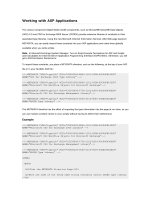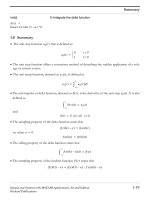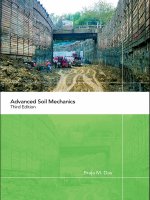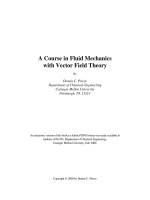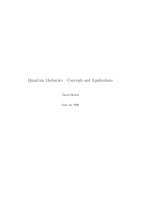Applied soil mechanics with abaqus applications
Bạn đang xem bản rút gọn của tài liệu. Xem và tải ngay bản đầy đủ của tài liệu tại đây (6.32 MB, 398 trang )
APPLIED SOIL MECHANICS
Applied Soil Mechanics: with ABAQUS Applications. Sam Helwany
© 2007 John Wiley & Sons, Inc. ISBN: 978-0-471-79107-2
APPLIED SOIL
MECHANICS
with ABAQUS Applications
SAM HELWANY
JOHN WILEY & SONS, INC.
Copyright 2007 by John Wiley & Sons, Inc., Hoboken, New Jersey. All rights reserved.
Published by John Wiley & Sons, Inc.
Published simultaneously in Canada
Wiley Bicentennial Logo: Richard J. Pacifico
No part of this publication may be reproduced, stored in a retrieval system, or transmitted in any form
or by any means, electronic, mechanical, photocopying, recording, scanning, or otherwise, except as
permitted under Section 107 or 108 of the 1976 United States Copyright Act, without either the prior
written permission of the Publisher, or authorization through payment of the appropriate per-copy fee
to the Copyright Clearance Center, Inc., 222 Rosewood Drive, Danvers, MA 01923, (978) 759-8400,
fax (978) 646-8600, or on the web at www.copyright.com. Requests to the Publisher for permission
should be addressed to the Permissions Department, John Wiley & Sons, Inc., 111 River Street,
Hoboken, NJ 07030, (201) 748-6011, fax (201) 748-6008, or online at
/>Limit of Liability/Disclaimer of Warranty: While the publisher and author have used their best efforts
in preparing this book, they make no representations or warranties with respect to the accuracy or
completeness of the contents of this book and specifically disclaim any implied warranties of
merchantability or fitness for a particular purpose. No warranty may be created or extended by sales
representatives or written sales materials. The advice and strategies contained herein may not be
suitable for your situation. You should consult with a professional where appropriate. Neither the
publisher nor author shall be liable for any loss of profit or any other commercial damages, including
but not limited to special, incidental, consequential, or other damages.
For general information on our other products and services please contact our Customer Care
Department within the United States at (800) 762-2974, outside the U.S. at (317) 572-3993 or
fax (317) 572-4002.
Wiley also publishes its books in a variety of electronic formats. Some content that appears in print,
however, may not be available in electronic books. For more information about Wiley products, visit
our web site at www.wiley.com.
Library of Congress Cataloging-in-Publication Data:
Helwany, Sam, 1958Applied soil mechanics with ABAQUS applications / Sam Helwany.
p. cm.
Includes index.
ISBN 978-0-471-79107-2 (cloth)
1. Soil mechanics. 2. Finite element method. 3. ABAQUS. I. Title.
TA710.H367 2007
624.1’5136–dc22
2006022830
Printed in the United States of America.
10 9 8 7 6 5 4 3 2 1
To the memory
of my parents
CONTENTS
PREFACE
1 PROPERTIES OF SOIL
1.1
1.2
1.3
1.4
1.5
1.6
1.7
1
Soil Formation / 1
Physical Parameters of Soils / 3
1.2.1 Relative Density / 7
Mechanical Properties of Soil / 8
1.3.1 Sieve Analysis / 8
1.3.2 Hydrometer Analysis / 10
Soil Consistency / 11
1.4.1 Liquid Limit / 12
1.4.2 Plastic Limit / 12
1.4.3 Shrinkage Limit / 12
Plasticity Chart / 13
Classification Systems / 14
Compaction / 16
2 ELASTICITY AND PLASTICITY
2.1
2.2
xiii
21
Introduction / 21
Stress Matrix / 22
vii
viii
CONTENTS
2.3
2.4
2.5
2.6
2.7
2.8
2.9
2.10
Elasticity / 23
2.3.1 Three-Dimensional Stress Condition / 23
2.3.2 Uniaxial Stress Condition / 24
2.3.3 Plane Strain Condition / 25
2.3.4 Plane Stress Condition / 27
Plasticity / 28
Modified Cam Clay Model / 28
2.5.1 Normal Consolidation Line and Unloading–Reloading
Lines / 30
2.5.2 Critical-State Line / 33
2.5.3 Yield Function / 36
2.5.4 Hardening and Softening Behavior / 36
2.5.5 Elastic Moduli for Soil / 38
2.5.6 Summary of Modified Cam Clay Model Parameters / 39
2.5.7 Incremental Plastic Strains / 40
2.5.8 Calculations of the Consolidated–Drained Stress–Strain
Behavior of a Normally Consolidated Clay Using the Modified
Cam Clay Model / 42
2.5.9 Step-by-Step Calculation Procedure for a CD Triaxial Test on
NC Clays / 44
2.5.10 Calculations of the Consolidated–Undrained Stress–Strain
Behavior of a Normally Consolidated Clay Using the Modified
Cam Clay Model / 47
2.5.11 Step-by-Step Calculation Procedure for a CU Triaxial Test on
NC Clays / 49
2.5.12 Comments on the Modified Cam Clay Model / 53
Stress Invariants / 53
2.6.1 Decomposition of Stresses / 55
Strain Invariants / 57
2.7.1 Decomposition of Strains / 57
Extended Cam Clay Model / 58
Modified Drucker–Prager/Cap Model / 61
2.9.1 Flow Rule / 63
2.9.2 Model Parameters / 64
Lade’s Single Hardening Model / 68
2.10.1 Elastic Behavior / 68
2.10.2 Failure Criterion / 68
2.10.3 Plastic Potential and Flow Rule / 69
2.10.4 Yield Criterion / 72
ix
CONTENTS
2.10.5 Predicting Soil’s Behavior Using Lade’s Model: CD Triaxial
Test Conditions / 82
3 STRESSES IN SOIL
3.1
3.2
3.3
Introduction / 90
In Situ Soil Stresses / 90
3.2.1 No-Seepage Condition / 93
3.2.2 Upward-Seepage Conditions / 97
3.2.3 Capillary Rise / 99
Stress Increase in a Semi-Infinite Soil Mass Caused by External
Loading / 101
3.3.1 Stresses Caused by a Point Load (Boussinesq Solution) / 102
3.3.2 Stresses Caused by a Line Load / 104
3.3.3 Stresses Under the Center of a Uniformly Loaded Circular
Area / 109
3.3.4 Stresses Caused by a Strip Load (B/L ≈ 0) / 114
3.3.5 Stresses Caused by a Uniformly Loaded Rectangular
Area / 116
4 CONSOLIDATION
4.1
4.2
4.3
4.4
5.4
124
Introduction / 124
One-Dimensional Consolidation Theory / 125
4.2.1 Drainage Path Length / 127
4.2.2 One-Dimensional Consolidation Test / 127
Calculation of the Ultimate Consolidation Settlement / 131
Finite Element Analysis of Consolidation Problems / 132
4.4.1 One-Dimensional Consolidation Problems / 133
4.4.2 Two-Dimensional Consolidation Problems / 147
5 SHEAR STRENGTH OF SOIL
5.1
5.2
5.3
90
Introduction / 162
Direct Shear Test / 163
Triaxial Compression Test / 170
5.3.1 Consolidated–Drained Triaxial Test / 172
5.3.2 Consolidated–Undrained Triaxial Test / 180
5.3.3 Unconsolidated–Undrained Triaxial Test / 185
5.3.4 Unconfined Compression Test / 186
Field Tests / 186
5.4.1 Field Vane Shear Test / 187
162
x
CONTENTS
5.5
5.4.2 Cone Penetration Test / 187
5.4.3 Standard Penetration Test / 187
Drained and Undrained Loading Conditions via FEM / 188
6 SHALLOW FOUNDATIONS
6.1
6.2
6.3
6.4
6.5
Introduction / 209
Modes of Failure / 209
Terzaghi’s Bearing Capacity Equation / 211
Meyerhof’s General Bearing Capacity Equation / 224
Effects of the Water Table Level on Bearing Capacity / 229
7 LATERAL EARTH PRESSURE AND RETAINING WALLS
7.1
7.2
7.3
7.4
7.5
7.6
233
Introduction / 233
At-Rest Earth Pressure / 236
Active Earth Pressure / 241
7.3.1 Rankine Theory / 242
7.3.2 Coulomb Theory / 246
Passive Earth Pressure / 249
7.4.1 Rankine Theory / 249
7.4.2 Coulomb Theory / 252
Retaining Wall Design / 253
7.5.1 Factors of Safety / 256
7.5.2 Proportioning Walls / 256
7.5.3 Safety Factor for Sliding / 257
7.5.4 Safety Factor for Overturning / 258
7.5.5 Safety Factor for Bearing Capacity / 258
Geosynthetic-Reinforced Soil Retaining Walls / 271
7.6.1 Internal Stability of GRS Walls / 272
7.6.2 External Stability of GRS Walls / 275
8 PILES AND PILE GROUPS
8.1
8.2
8.3
209
Introduction / 286
Drained and Undrained Loading Conditions / 286
Estimating the Load Capacity of Piles / 291
8.3.1 α-Method / 291
8.3.2 β-method / 297
286
CONTENTS
8.4
8.5
8.6
Pile Groups / 301
8.4.1 α-Method / 304
8.4.2 β-Method / 304
Settlements of Single Piles and Pile Groups / 312
Laterally Loaded Piles and Pile Groups / 313
8.6.1 Broms’ Method / 314
8.6.2 Finite Element Analysis of Laterally Loaded Piles / 317
9 PERMEABILITY AND SEEPAGE
9.1
9.2
9.3
9.4
9.5
9.6
9.7
9.8
9.9
9.10
9.11
9.12
xi
332
Introduction / 332
Bernoulli’s Equation / 333
Darcy’s Law / 337
Laboratory Determination of Permeability / 338
Permeability of Stratified Soils / 340
Seepage Velocity / 342
Stresses in Soils Due to Flow / 343
Seepage / 346
Graphical Solution: Flow Nets / 349
9.9.1 Calculation of Flow / 350
9.9.2 Flow Net Construction / 351
Flow Nets for Anisotropic Soils / 354
Flow Through Embankments / 355
Finite Element Solution / 356
REFERENCES
377
INDEX
381
PREFACE
The purpose of this book is to provide civil engineering students and practitioners
with simple basic knowledge on how to apply the finite element method to soil
mechanics problems. This is essentially a soil mechanics book that includes traditional soil mechanics topics and applications. The book differs from traditional soil
mechanics books in that it provides a simple and more flexible alternative using
the finite element method to solve traditional soil mechanics problems that have
closed-form solutions. The book also shows how to apply the finite element method
to solve more complex geotechnical engineering problems of practical nature that
do not have closed-form solutions.
In short, the book is written mainly for undergraduate students, to encourage
them to solve geotechnical engineering problems using both traditional engineering
solutions and the more versatile finite element solutions. This approach not only
teaches the concepts but also provides means to gain more insight into geotechnical engineering applications that reinforce the concepts in a very profound manner.
The concepts are presented in a basic form so that the book can serve as a valuable
learning aid for students with no background in soil mechanics. The main prerequisite would be strength of materials (or equivalent), which is a prerequisite for
soil mechanics in most universities.
General soil mechanics principles are presented for each topic, followed by traditional applications of these principles with longhand solutions, which are followed
in turn by finite element solutions for the same applications, and then both solutions
are compared. Further, more complex applications are presented and solved using
the finite element method.
xiii
xiv
PREFACE
The book consist of nine chapters, eight of which deal with traditional soil
mechanics topics, including stresses in semi-infinite soil mass, consolidation, shear
strength, shallow foundations, lateral earth pressure, deep foundations (piles), and
seepage. The book includes one chapter (Chapter 2) that describes several elastic
and elastoplastic material models, some of which are used within the framework of
the finite element method to simulate soil behavior, and that includes a generalized
three-dimensional linear elastic model, the Cam clay model, the cap model and
Lade’s model. For undergraduate teaching, one can include a brief description of
the essential characteristics and parameters of the Cam clay model and the cap
model without much emphasis on their mathematical derivations.
Over 60 solved examples appear throughout the book. Most are solved longhand
to illustrate the concepts and then solved using the finite element method embodied
in a computer program: ABAQUS. All finite element examples are solved using
ABAQUS. This computer program is used worldwide by educators and engineers to
solve various types of civil engineering and engineering mechanics problems. One
of the major advantages of using this program is that it is capable of solving most
geotechnical engineering problems. The program can be used to tackle geotechnical
engineering problems involving two- and three-dimensional configurations that may
include soil and structural elements, total and effective stress analysis, consolidation analysis, seepage analysis, static and dynamic (implicit and explicit) analysis,
failure and post-failure analysis, and a lot more. Nevertheless, other popular finite
element or finite difference computer programs specialized in soil mechanics can be
used in conjunction with this book in lieu of ABAQUS—obviously, this depends
on the instructor’s preference.
The PC Education Version of ABAQUS can be obtained via the internet so
that the student and practitioner can use it to rework the examples of the book
and to solve the homework assignments, which can be chosen from those end-ofchapter problems provided. Furthermore, the input data for all examples can be
downloaded from the book’s website (www.wiley.com/college/helwany). This can
be very useful for the student and practitioner, since they can see how the input
should be for a certain problem, then can modify the input data to solve more
complex problems of the same class.
I express my deepest appreciation to the staff at John Wiley & Sons Publishing
Company, especially Mr. J. Harper, Miss K. Nasdeo, and Miss M. Torres for their
assistance in producing the book. I am also sincerely grateful to Melody Clair for
her editing parts of the manuscript.
Finally, a very special thank you to my family, Alba, Eyad, and Omar, and my
brothers and sisters for their many sacrifices during the development of the book.
CHAPTER 1
PROPERTIES OF SOIL
1.1
SOIL FORMATION
Soil is a three-phase material consisting of solid particles, water, and air. Its mechanical behavior is largely dependent on the size of its solid particles and voids. The
solid particles are formed from physical and chemical weathering of rocks. Therefore, it is important to have some understanding of the nature of rocks and their
formation.
A rock is made up of one or more minerals. The characteristics of a particular
rock depend on the minerals it contains. This raises the question: What is a mineral?
By definition, a mineral is a naturally occurring inorganic element or compound
in a solid state. More than 4000 different minerals have been discovered but only
10 elements make up 99% of Earth’s crust (the outer layer of Earth): oxygen (O),
silicon (Si), aluminum (Al), iron (Fe), calcium (Ca), sodium (Na), potassium (K),
magnesium (Mg), titanium (Ti), and hydrogen (H). Most of the minerals (74%) in
Earth’s crust contain oxygen and silicon. The silicate minerals, containing oxygen
and silicon, comprise 90% of all rock-forming minerals. One of the interesting
minerals in soil mechanics is the clay mineral montmorillonite (an expansive clay),
which can expand up to 15 times its original volume if water is present. When
expanding, it can produce pressures high enough to damage building foundations
and other structures.
Since its formation, Earth has been subjected to continuous changes caused by
seismic, volcanic, and climatic activities. Moving from the surface to the center of
Earth, a distance of approximately 6370 km, we encounter three different layers.
The top (outer) layer, the crust, has an average thickness of 15 km and an average
density of 3000 kg/m3 . By comparison, the density of water is 1000 kg/m3 and
that of iron is 7900 kg/m3 . The second layer, the mantle, has an average thickness
1
Applied Soil Mechanics: with ABAQUS Applications. Sam Helwany
© 2007 John Wiley & Sons, Inc. ISBN: 978-0-471-79107-2
2
PROPERTIES OF SOIL
of 3000 km and an average density of 5000 kg/m3 . The third, the core, contains
primarily nickel and iron and has an average density of 11,000 kg/m3 .
Within the crust, there are three major groups of rocks:
1. Igneous rocks, which are formed by the cooling of magma. Fast cooling
occurs above the surface, producing igneous rocks such as basalt, whereas
slow cooling occurs below the surface, producing other types of igneous
rocks, such as granite and dolerite. These rocks are the ancestors of sedimentary and metamorphic rocks.
2. Sedimentary rocks, which are made up of particles and fragments derived
from disintegrated rocks that are subjected to pressure and cementation caused
by calcite and silica. Limestone (chalk) is a familiar example of a sedimentary
rock.
3. Metamorphic rocks, which are the product of existing rocks subjected to
changes in pressure and temperature, causing changes in mineral composition
of the original rocks. Marble, slate, and schist are examples of metamorphic
rocks.
Note that about 95% of the outer 10 km of Earth’s crust is made up of igneous
and metamorphic rocks, and only 5% is sedimentary. But the exposed surface of
the crust contains at least 75% sedimentary rocks.
Soils Soils are the product of physical and chemical weathering of rocks. Physical weathering includes climatic effects such as freeze–thaw cycles and erosion by
wind, water, and ice. Chemical weathering includes chemical reaction with rainwater. The particle size and the distribution of various particle sizes of a soil depend
on the weathering agent and the transportation agent.
Soils are categorized as gravel, sand, silt, or clay, depending on the predominant
particle size involved. Gravels are small pieces of rocks. Sands are small particles
of quartz and feldspar. Silts are microscopic soil fractions consisting of very fine
quartz grains. Clays are flake-shaped microscopic particles of mica, clay minerals,
and other minerals. The average size (diameter) of solid particles ranges from 4.75
to 76.2 mm for gravels and from 0.075 to 4.75 mm for sands. Soils with an average
particle size of less than 0.075 mm are either silt or clay or a combination of the
two.
Soils can also be described based on the way they were deposited. If a soil is
deposited in the vicinity of the original rocks due to gravity alone, it is called a
residual soil. If a soil is deposited elsewhere away from the original rocks due
to a transportation agent (such as wind, ice, or water), it is called a transported
soil.
Soils can be divided into two major categories: cohesionless and cohesive. Cohesionless soils, such as gravelly, sandy, and silty soils, have particles that do not
adhere (stick) together even with the presence of water. On the other hand, cohesive soils (clays) are characterized by their very small flakelike particles, which
can attract water and form plastic matter by adhering (sticking) to each other. Note
PHYSICAL PARAMETERS OF SOILS
3
that whereas you can make shapes out of wet clay (but not too wet) because of its
cohesive characteristics, it is not possible to do so with a cohesionless soil such as
sand.
1.2
PHYSICAL PARAMETERS OF SOILS
Soils contain three components: solid, liquid, and gas. The solid components of
soils are the product of weathered rocks. The liquid component is usually water,
and the gas component is usually air. The gaps between the solid particles are
called voids. As shown in Figure 1.1a, the voids may contain air, water, or both.
Let us discuss the soil specimen shown in Figure 1.1a. The total volume (V ) and
the total weight (W ) of the specimen can be measured in the laboratory. Next,
let us separate the three components of the soil as shown in Figure 1.1b. The
solid particles are gathered in one region such that there are no voids in between,
as shown in the figure (this can only be done theoretically). The volume of this
component is Vs and its weight is Ws . The second component is water, whose
volume is Vw and whose weight is Ww . The third component is the air, which has
a volume Va and a very small weight that can be assumed to be zero. Note that
the volume of voids (Vv ) is the sum of Va and Vw . Therefore, the total volume is
V = Vv + Vs = Va + Vw + Vs . Also, the total weight W = Ww + Ws .
In the following we present definitions of several basic soil parameters that
hold important physical meanings. These basic parameters will be used to obtain
relationships that are useful in soil mechanics.
The void ratio e is the proportion of the volume of voids with respect to the
volume of solids:
e=
Vv
Vs
(1.1)
n=
Vv
V
(1.2)
The porosity n is given as
0
Air
Va
Ww
Water
Vw
Water
Vv
V
W
Voids
Air
Ws
Solids
Vs
Solids
(a)
(b)
FIGURE 1.1 (a) Soil composition; (b) phase diagram.
4
PROPERTIES OF SOIL
Note that
e=
n
Vv
Vv /V
Vv
=
=
=
Vs
V − Vv
V /V − Vv /V
1−n
(1.3)
e
1+e
(1.4)
Vw
Vv
(1.5)
or
n=
The degree of saturation is defined as
S=
Note that when the soil is fully saturated, all the voids are filled with water (no
air). In that case we have Vv = Vw . Substituting this into (1.5) yields S = 1 (or
100% saturation). On the other hand, if the soil is totally dry, we have Vw = 0;
therefore, S = 0 (or 0% saturation).
The moisture content (or water content) is the proportion of the weight of water
with respect to the weight of solids:
ω=
Ww
Ws
(1.6)
The water content of a soil specimen is easily measured in the laboratory by
weighing the soil specimen first to get its total weight, W . Then the specimen
is dried in an oven and weighed to get Ws . The weight of water is then calculated as Ww = W − Ws . Simply divide Ww by Ws to get the moisture content,
(1.6).
Another useful parameter is the specific gravity Gs , defined as
Gs =
γs
Ws /Vs
=
γw
γw
(1.7)
where γs is the unit weight of the soil solids (not the soil itself) and γw is the unit
weight of water (γw = 9.81 kN/m3 ). Note that the specific gravity represents the
relative unit weight of solid particles with respect to water. Typical values of Gs
range from 2.65 for sands to 2.75 for clays.
The unit weight of soil (the bulk unit weight) is defined as
γ=
W
V
(1.8)
and the dry unit weight of soil is given as
γd =
Ws
V
(1.9)
PHYSICAL PARAMETERS OF SOILS
5
Substituting (1.6) and (1.9) into (1.8), we get
γ=
Ws + Ww
Ws + ωWs
Ws (1 + ω)
W
=
=
=
= γd (1 + ω)
V
V
V
V
or
γd =
γ
1+ω
(1.10)
Let us assume that the volume of solids Vs in Figure 1.1b is equal to 1 unit (e.g.,
1 m3 ). Substitute Vs = 1 into (1.1) to get
e=
Vv
Vv
→ Vv = e
=
Vs
1
(1.11)
Thus,
V = Vs + Vv = 1 + e
(1.12)
Substituting Vs = 1 into (1.7) we get
Gs =
γs
Ws /Vs
Ws /1
=
=
→ Ws = γ w G s
γw
γw
γw
(1.13)
Substitute (1.13) into (1.6) to get
Ww = ωWs = ωγw Gs
(1.14)
Finally, substitute (1.12), (1.13), and (1.14) into (1.8) and (1.9) to get
γ=
Ws + Ww
γw Gs + ωγw Gs
γw Gs (1 + ω)
W
=
=
=
V
V
1+e
1+e
(1.15)
γw Gs
Ws
=
V
1+e
(1.16)
and
γd =
Another interesting relationship can be obtained from (1.5):
S=
Vw
ωGs
Ww /γw
ωγw Gs /γw
=
→ eS = ωGs
=
=
Vv
Vv
e
e
(1.17)
Equation (1.17) is useful for estimating the void ratio of saturated soils based
on their moisture content. For a saturated soil S = 1 and the value of Gs can
be assumed (2.65 for sands and 2.75 for clays). The moisture content can be
obtained from a simple laboratory test (described earlier) performed on a soil
6
PROPERTIES OF SOIL
specimen taken from the field. An approximate in situ void ratio is calculated as
e = ωGs ≈ (2.65 − 2.75)ω.
For a fully saturated soil, we have e = ωGs → Gs = e/ω. Substituting this into
(1.15), we can obtain the following expression for the saturated unit weight:
γsat =
γw [Gs + ωe/ω]
γw (Gs + e)
γw Gs (1 + ω)
=
=
1+e
1+e
1+e
(1.18)
Example 1.1 A 0.9-m3 soil specimen weighs 17 kN and has a moisture content of
9%. The specific gravity of the soil solids is 2.7. Using the fundamental equations
(1.1) to (1.10), calculate (a) γ, (b) γd , (c) e, (d) n, (e) Vw , and (f) S.
SOLUTION: Given: V = 0.9 m3 , W = 17 kN, ω = 9%, and Gs = 2.7.
(a) From the definition of unit weight, (1.8):
γ=
17 kN
W
=
= 18.9 kN/m3
V
0.9 m3
(b) From (1.10):
γd =
18.9 kN/m3
γ
=
= 17.33 kN/m3
1+ω
1 + 0.09
(c) From (1.9):
γd =
Ws
→ Ws = γd V = 17.33 kN/m3 × 0.9 m3 = 15.6 kN
V
From the phase diagram (Figure 1.1b), we have
Ww = W − Ws = 17 kN − 15.6 kN = 1.4 kN
From (1.7):
Gs =
γs
Ws /Vs
Ws
15.6 kN
= 0.5886 m3
=
→ Vs =
=
γw
γw
γw Gs
9.81 kN/m3 × 2.7
Also, from the phase diagram (Figure 1.1b), we have
Vv = V − Vs = 0.9 m3 − 0.5886 m3 = 0.311 m3
From (1.1) we get
e=
Vv
0.311 m3
=
= 0.528
Vs
0.5886 m3
PHYSICAL PARAMETERS OF SOILS
7
(d) Equation (1.2) yields
n=
0.311 m3
Vv
=
= 0.346
V
0.9 m3
(e) From the definition of the unit weight of water,
Vw =
Ww
1.4 kN
=
= 0.143 m3
γw
9.81 kN/m3
(f) Finally, from (1.5):
S=
1.2.1
0.143 m3
Vw
=
= 0.459 = 45.9%
Vv
0.311 m3
Relative Density
The compressibility and strength of a granular soil are related to its relative density
Dr , which is a measure of the compactness of the soil grains (their closeness to
each other). Consider a uniform sand layer that has an in situ void ratio e. It is
possible to tell how dense this sand is if we compare its in situ void ratio with the
maximum and minimum possible void ratios of the same sand. To do so, we can
obtain a sand sample from the sand layer and perform two laboratory tests (ASTM
2004: Test Designation D-4253). The first laboratory test is carried out to estimate
the maximum possible dry unit weight γd−max (which corresponds to the minimum
possible void ratio emin ) by placing a dry sand specimen in a container with a
known volume and subjecting the specimen to a surcharge pressure accompanied
with vibration. The second laboratory test is performed to estimate the minimum
possible dry unit weight γd−min (which corresponds to the maximum possible void
ratio emax ) by pouring a dry sand specimen very loosely in a container with a
known volume. Now, let us define the relative density as
Dr =
emax − e
emax − emin
(1.19)
This equation allows us to compare the in situ void ratio directly with the maximum
and minimum void ratios of the same granular soil. When the in situ void ratio e
of this granular soil is equal to emin , the soil is at its densest possible condition and
Dr is equal to 1 (or Dr = 100%). When e is equal to emax , the soil is at its loosest
possible condition, and its Dr is equal to 0 (or Dr = 0%). Note that the dry unit
weight is related to the void ratio through the equation
γd =
Gs γw
1+e
(1.20)
8
PROPERTIES OF SOIL
It follows that
γd−max =
1.3
Gs γw
1 + emin
and γd−min =
Gs γw
1 + emax
MECHANICAL PROPERTIES OF SOIL
Soil engineers usually classify soils to determine whether they are suitable for
particular applications. Let us consider three borrow sites from which we need
to select a soil that has the best compaction characteristics for a nearby highway
embankment construction project. For that we would need to get details about the
grain-size distribution and the consistency of each soil. Then we can use available
charts and tables that will give us the exact type of each soil. From experience
and/or from available charts and tables we can determine which of these soils has
the best compaction characteristics based on its classification.
Most soil classification systems are based on the grain-size distribution curve and
the Atterberg limits for a given soil. The grain-size analysis is done using sieve
analysis on the coarse portion of the soil (> 0.075 mm in diameter), and using
hydrometer analysis on the fine portion of the soil (< 0.075 mm in diameter). The
consistency of soil is characterized by its Atterberg limits as described below.
1.3.1
Sieve Analysis
A set of standardized sieves is used for the analysis. Each sieve is 200 mm in diameter and 50 mm in height. The opening size of the sieves ranges from 0.075 mm
for sieve No. 200 to 4.75 mm for sieve No. 4. Table 1.1 lists the designation of
each sieve and the corresponding opening size. As shown in Figure 1.2, a set of
sieves stacked in descending order (the sieve with the largest opening size is on
top) is secured on top of a standardized shake table. A dry soil specimen is then
TABLE 1.1 Standard Sieve Sizes
Sieve No.
Opening Size (mm)
4
10
20
40
60
80
100
120
140
170
200
4.75
2.00
0.85
0.425
0.250
0.180
0.15
0.125
0.106
0.090
0.075
MECHANICAL PROPERTIES OF SOIL
Gravel
Sieve
No. 4
Sand
No. 10
Sand
No. 40
Sand
No. 80
Sand
No. 120
Sand
No. 170
Sand
No. 200
Silt and Clay
9
Pan
FIGURE 1.2 Typical set of U.S. standard sieves.
0.075 mm
4.75 mm
Gravel
Sand
Silt and Clay
100
Percent Passing
80
B
60
A
40
20
0
100
10
1
0.1
d60
d30
Particle Diameter (mm)
0.01
0.001
d10
FIGURE 1.3 Particle-size distribution curve.
shaken through the sieves for 10 minutes. As shown in Figure 1.3, the percent by
weight of soil passing each sieve is plotted as a function of the grain diameter
(corresponding to a sieve number as shown in Table 1.1). It is customary to use a
logarithmic horizontal scale on this plot.
Figure 1.3 shows two grain-size distribution curves, A and B. Curve A represents
a uniform soil (also known as poorly graded soil) that includes a narrow range
of particle sizes. This means that the soil is not well proportioned, hence the
expression “poorly graded soil.” In this example, soil A is uniform coarse sand.
On the other hand, curve B represents a nonuniform soil (also known as well-graded
10
PROPERTIES OF SOIL
soil) that includes a wide spectrum of particle sizes. In this case the soil is well
proportioned—it includes gravel, sand (coarse, medium, and fine), and silt/clay.
There are two useful indicators, Cu and Cc , that can be obtained from the grain-size
distribution curve. Cu is the uniformity coefficient, defined as Cu = d60 /d10 , and Cc
2
is the coefficient of gradation, defined as Cc = d30
/(d10 d60 ). Here d10 , d30 , and d60
are the grain diameters corresponding respectively to 10%, 30%, and 60% passing, as
shown in Figure 1.3. For a well-graded sand the value of the coefficient of gradation
should be in the range 1 ≤ Cc ≤ 3. Also, higher values of the uniformity coefficient
indicate that the soil contains a wider range of particle sizes.
1.3.2
Hydrometer Analysis
Sieve analysis cannot be used for clay and silt particles because they are too
small (<0.075 mm in diameter) and they will be suspended in air for a long time
during shaking. The grain-size distribution of the fine-grained portion that passes
sieve No. 200 can be obtained using hydrometer analysis. The basis of hydrometer
analysis is that when soil particles are dispersed in water, they will settle at different
velocities because of their different sizes. Assuming that soil particles are perfect
spheres dispersed in water with a viscosity η, Stokes’ law can be used to relate the
terminal velocity v of a particle to its diameter D:
v=
ρs − ρw 2
D
18η
(1.21)
in which ρs is the density of soil particles and ρw is the density of water.
Equation (1.21) indicates that a larger particle will have a greater terminal velocity
when dropping through a fluid.
In the hydrometer laboratory test (ASTM 2004) a dry soil specimen weighing
50 g is mixed thoroughly with water and placed in a graduated 1000-mL glass
flask. A floating instrument called a hydrometer (Figure 1.4) is placed in the flask
to measure the specific gravity of the mixture in the vicinity of the hydrometer
center. In a 24-hour period the time t and the corresponding depth L are recorded.
The measured depth (see Figure 1.4) is correlated with the amount of soil that is
still in suspension at time t. From Stokes’ law, (1.21), it can be shown that the
diameter of the largest soil particles still in suspension is given by
D=
18η
L
[(ρs /ρw ) − 1]γw t
(1.22)
in which γw is the unit weight of water. From the hydrometer readings (L versus t)
and with the help of (1.22), one can calculate the percent of finer particles and plot
a gradation curve. The part of curve B (Figure 1.3) with particle diameter smaller
than 0.075 mm is obtained from a hydrometer test.
SOIL CONSISTENCY
11
Hydrometer
L
1000-mL
Flask
FIGURE 1.4
1.4
Hydrometer test.
SOIL CONSISTENCY
Clays are flake-shaped microscopic particles of mica, clay minerals, and other
minerals. Clay possesses a large specific surface, defined as the total surface of
clay particles per unit mass. For example, the specific surfaces of the three main
clay minerals; kaolinite, illite, and montmorillonite, are 15, 80, and 800 m2 /g,
respectively. It is mind-boggling that just 1 g of montmorillonite has a surface of
800 m2 ! This explains why clays are fond of water. It is a fact that the surface
of a clay mineral has a net negative charge. Water, on the other hand, has a
net positive charge. Therefore, the clay surface will bond to water if the latter
is present. A larger specific surface means more absorbed water. As mentioned
earlier, montmorillonite can increase 15-fold in volume if water is present, due
to its enormous specific surface. Montmorillonite is an expansive clay that causes
damage to adjacent structures if water is added (rainfall). It also shrinks when it
dries, causing another type of damage to structures. Illite is not as expansive, due
to its moderate specific surface. Kaolinite is the least expansive.
It is clear that the moisture (water) content has a great effect on a clayey soil,
especially in terms of its response to applied loads. Consider a very wet clay
specimen that looks like slurry (fluid). In this liquid state the clay specimen has
no strength (i.e., it cannot withstand any type of loading). Consider a potter’s clay
specimen that has a moderate amount of moisture. This clay is in its plastic state
because in this state we can actually make shapes out of the clay knowing that it
will not spring back as elastic materials do. If we let this plastic clay dry out for
a short time (i.e., so that it is not totally dry), it will lose its plasticity because if
we try to shape it now, many cracks will appear, indicating that the clay is in its
semisolid state. If the specimen dries out further, it reaches its solid state, where it
becomes exceedingly brittle.
12
PROPERTIES OF SOIL
Atterberg limits divide the four states of consistency described above. These
three limits are obtained in the laboratory on reconstituted soil specimens using
the techniques developed early in the twentieth century by a Swedish scientist. As
shown in Figure 1.5, the liquid limit (LL) is the dividing line between the liquid and
plastic states. LL corresponds to the moisture content of a soil as it changes from
the plastic state to the liquid state. The plastic limit (PL) is the moisture content of
a soil when it changes from the plastic to the semisolid state. The shrinkage limit
(SL) is the moisture content of a soil when it changes from the semisolid state to the
solid state. Note that the moisture content in Figure 1.5 increases from left to right.
1.4.1
Liquid Limit
The liquid limit is obtained in the laboratory using a simple device that includes
a shallow brass cup and a hard base against which the cup is bumped repeatedly
using a crank-operated mechanism. The cup is filled with a clay specimen (paste),
and a groove is cut in the paste using a standard tool. The liquid limit is the
moisture content at which the shear strength of the clay specimen is so small that
the soil “flows” to close the aforementioned groove at a standard number of blows
(ASTM 2004: Designation D-4318).
1.4.2
Plastic Limit
The plastic limit is defined as the moisture content at which a soil crumbles when
rolled down into threads 3 mm in diameter (ASTM 2004: Designation D-4318). To
do that, use your hand to roll a round piece of clay against a glass plate. Being able
to roll a moist piece of clay is an indication that it is now in its plastic state (see
Figure 1.5). By rolling the clay against the glass, it will lose some of its moisture
moving toward its semisolid state, as indicated in the figure. Crumbling of the
thread indicates that it has reached its semisolid state. The moisture content of the
thread at that stage can be measured to give us the plastic limit, which is the verge
between the plastic and semisolid states.
1.4.3
Shrinkage Limit
In its semisolid state, soil has some moisture. As a soil loses more moisture, it
shrinks. When shrinking ceases, the soil has reached its solid state. Thus, the
Semisolid
Solid
0
SL
Plastic
PL
Liquid
LL
PI = LL − PL
FIGURE 1.5 Atterberg limits.
ω (%)
PLASTICITY CHART
13
moisture content at which a soil ceases to shrink is the shrinkage limit, which is
the verge between the semisolid and solid states.
1.5
PLASTICITY CHART
A useful indicator for the classification of fine-grained soils is the plasticity index
(PI), which is the difference between the liquid limit and the plastic limit
(PI = LL − PL). Thus, PI is the range within which a soil will behave as a plastic
material. The plasticity index and the liquid limit can be used to classify fine-grained
soils via the Casagrande (1932) empirical plasticity chart shown in Figure 1.6. The
line shown in Figure 1.6 separates silts from clays. In the plasticity chart, the liquid limit of a given soil determines its plasticity: Soils with LL ≤ 30 are classified
as low-plasticity clays (or low-compressibility silts); soils with 30 < LL ≤ 50 are
medium-plasticity clays (or medium-compressibility silts); and soils with LL > 50
are high-plasticity clays (or high-compressibility silts). For example, a soil with
LL = 40 and PI = 10 (point A in Figure 1.6) is classified as silt with medium
compressibility, whereas a soil with LL = 40 and PI = 20 (point B in Figure 1.6)
can be classified as clay of medium plasticity.
To determine the state of a natural soil with an in situ moisture content ω, we
can use the liquidity index (LI), defined as
LI =
60
Low
Plasticity
ω − PL
LL − PL
Medium
Plasticity
(1.23)
High
Plasticity
50
ne
Li
40
s
Cl
lts
ay
30
Si
Plasticity Index
A-
20
B
10
A
0
0
10
20
30
40
50
60
Liquid Limit
70
FIGURE 1.6 Plasticity chart.
80
90
100
